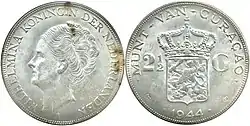Curaçao and Dependencies
The Colony of Curaçao and Dependencies (Dutch: Kolonie Curaçao en onderhorigheden; Papiamento: Kolonia di Kòrsou i dependensianan) was a Dutch colony in the Caribbean Sea from 1815 until 1828 and from 1845 until 1954. Between 1936 and 1948, the area was officially known as the Territory of Curaçao (Dutch: Gebiedsdeel Curaçao; Papiamento: Teritorio di Kòrsou), and after 1948 as the Netherlands Antilles. With the proclamation of the Charter for the Kingdom of the Netherlands on 15 December 1954, the Netherlands Antilles attained equal status with the Netherlands proper and Suriname in the new Kingdom of the Netherlands.
Territory of Curaçao and Dependencies | |||||||||
|---|---|---|---|---|---|---|---|---|---|
| 1810–1950 | |||||||||
 Coat of arms
| |||||||||
_(14563454738).jpg.webp) Map of the Caribbean, 1893. Aruba, Curaçao and Bonaire are shaded in red. | |||||||||
| Status | Dutch colony | ||||||||
| Capital | Willemstad | ||||||||
| Common languages | Papiamento, Dutch, English | ||||||||
| History | |||||||||
• Established | November 20 1810 | ||||||||
• Proclamation of the Kingdom charter | December 10 1950 | ||||||||
| |||||||||
History
Under the terms of the Anglo-Dutch Treaty of 1814, the Netherlands regained control over its West Indies colonies, with the exception of Demerara, Essequibo, and Berbice. In the newly established United Kingdom of the Netherlands, these colonies were organized in the following way until 1828:[1]
| Name | Capital | Comprised |
|---|---|---|
| Curaçao and Dependencies | Willemstad | Curaçao, Aruba, Bonaire |
| Sint Eustatius and Dependencies | Oranjestad | Sint Eustatius, Sint Maarten, Saba |
| Suriname | Paramaribo | Suriname |
As a cost-reducing measure, the three colonies were merged into a single West Indies colony ruled from Paramaribo, Suriname, in 1828. This proved to be an unhappy arrangement, causing it to be partially reverted in 1845. Sint Eustatius did not regain its status as a separate colony, however, and came to be ruled from Willemstad, Curaçao:
| Name | Capital | Comprised |
|---|---|---|
| Curaçao and Dependencies | Willemstad | Curaçao, Aruba, Bonaire, Sint Eustatius, Sint Maarten, Saba |
| Suriname | Paramaribo | Suriname |
Politics

In 1865, Curaçao's government regulation (Dutch: Regeringsreglement voor Curaçao en onderhorige eilanden) was altered to allow for a limited autonomy for the colony. The structure established in this regulation remained in force until 1936, when the first Constitution of Curaçao was enacted. This new basic law followed on a revision of the Dutch constitution in 1922, in which all references to "colony" were deleted. In the new parliament established in the colony, the Estates of Curaçao, ten out of fifteen members were elected by popular vote, with the remaining five being appointed by the governor. Only about 5% of the population of both colonies was allowed to vote in the elections.[2][3]
Gradual decolonization
The reforms in the government structure of the colony until the Second World War were largely superficial, and thus Curaçao continued to be governed as a colony. This changed after the conclusion of the Second World War. Queen Wilhelmina had promised in a 1942 speech to offer autonomy to the overseas territories of the Netherlands, and British and American occupation—with consent by the Dutch government—of the islands during the war led to increasing demands for autonomy within the population as well.[4]
In May 1948, a new constitution for the territory entered into force, allowing the largest amount of autonomy allowed under the Dutch constitution of 1922. Among other things, universal suffrage was introduced. The territory was renamed to "Netherlands Antilles" as well. After the Dutch constitution was revised in 1948, a new interim Constitution of the Netherlands Antilles was enacted in February 1951. Shortly thereafter, on 3 March 1951, the Island Regulation of the Netherlands Antilles (Dutch: Eilandenregeling Nederlandse Antillen or ERNA; Papiamento: Regulashon Insular delas Antias Hulandes or RIAH) was issued by royal decree, giving fairly substantial autonomy to the various island territories in the Netherlands Antilles. A consolidated version of this regulation remained in force until the dissolution of the Netherlands Antilles in 2010.[5][6]
The new constitution was only deemed an interim arrangement, as negotiations for a Charter for the Kingdom were already underway. On 15 December 1954, the Netherlands Antilles, Suriname, and the Netherlands acceded as equal partners to an overarching Kingdom of the Netherlands as established in the Charter for the Kingdom of the Netherlands. With this move, the United Nations deemed decolonization of the territory complete and removed it from the United Nations list of non-self-governing territories.[7]
Notes
- Walle 1975, p. 114.
- Oostindie & Klinkers 2001, pp. 12–13.
- Oostindie 2003, p. 61.
- Oostindie & Klinkers 2001, pp. 29–32.
- Oostindie & Klinkers 2001, pp. 41–44.
- "KONINKLIJK BESLUIT van 3 maart 1951, houdende de eilandenregeling Nederlandse Antillen" [ROYAL DECREE of March 3, 1951, containing the island regulation of the Netherlands Antilles]. Overheid. 22 July 2006.
- Oostindie & Klinkers 2001, pp. 47–56.
References
- Kompagnie, Jan H. (1996). Soldaten overzee: aanwijzingen voor het doen van onderzoek naar onderofficieren en minderen bij het Koninklijk Nederlandsch-Indisch Leger (KNIL) en bij het leger in West-Indië (1815–1949). Den Haag: Algemeen Rijksarchief. ISBN 9074920071.
- Oostindie, Gert & Klinkers, Inge (2001). Het Koninkrijk in de Caraïben: een korte geschiedenis van het Nederlandse dekolonisatiebeleid 1940-2000. Amsterdam: Amsterdam University Press.
- Oostindie, Gert (2003). Decolonising The Caribbean: Dutch Policies In A Comparative Perspective. Amsterdam: Amsterdam University Press. ISBN 9789053566541.
- Walle, J. van de (1975). Een oog boven Paramaribo (in Dutch). Amsterdam: Querido. ISBN 9021414007.
